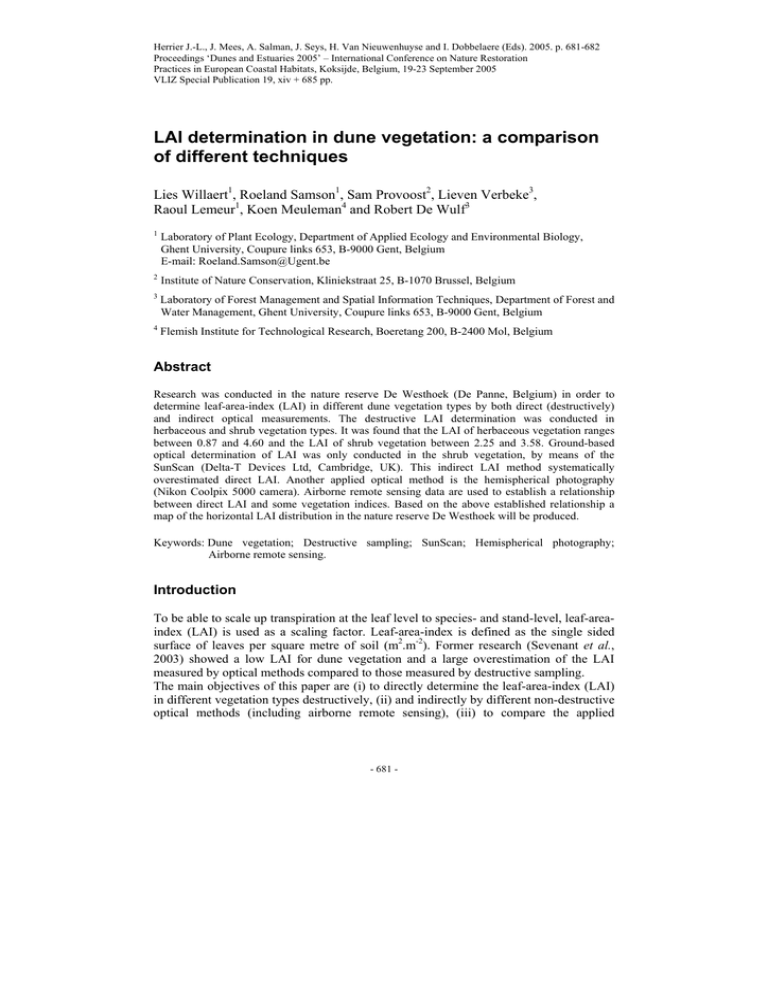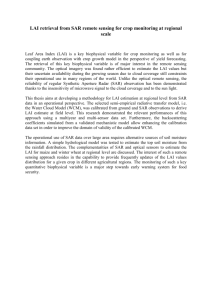Document 11769559
advertisement

Herrier J.-L., J. Mees, A. Salman, J. Seys, H. Van Nieuwenhuyse and I. Dobbelaere (Eds). 2005. p. 681-682 Proceedings ‘Dunes and Estuaries 2005’ – International Conference on Nature Restoration Practices in European Coastal Habitats, Koksijde, Belgium, 19-23 September 2005 VLIZ Special Publication 19, xiv + 685 pp. LAI determination in dune vegetation: a comparison of different techniques Lies Willaert1, Roeland Samson1, Sam Provoost2, Lieven Verbeke3, Raoul Lemeur1, Koen Meuleman4 and Robert De Wulf3 1 Laboratory of Plant Ecology, Department of Applied Ecology and Environmental Biology, Ghent University, Coupure links 653, B-9000 Gent, Belgium E-mail: Roeland.Samson@Ugent.be 2 Institute of Nature Conservation, Kliniekstraat 25, B-1070 Brussel, Belgium 3 Laboratory of Forest Management and Spatial Information Techniques, Department of Forest and Water Management, Ghent University, Coupure links 653, B-9000 Gent, Belgium 4 Flemish Institute for Technological Research, Boeretang 200, B-2400 Mol, Belgium Abstract Research was conducted in the nature reserve De Westhoek (De Panne, Belgium) in order to determine leaf-area-index (LAI) in different dune vegetation types by both direct (destructively) and indirect optical measurements. The destructive LAI determination was conducted in herbaceous and shrub vegetation types. It was found that the LAI of herbaceous vegetation ranges between 0.87 and 4.60 and the LAI of shrub vegetation between 2.25 and 3.58. Ground-based optical determination of LAI was only conducted in the shrub vegetation, by means of the SunScan (Delta-T Devices Ltd, Cambridge, UK). This indirect LAI method systematically overestimated direct LAI. Another applied optical method is the hemispherical photography (Nikon Coolpix 5000 camera). Airborne remote sensing data are used to establish a relationship between direct LAI and some vegetation indices. Based on the above established relationship a map of the horizontal LAI distribution in the nature reserve De Westhoek will be produced. Keywords: Dune vegetation; Destructive sampling; SunScan; Hemispherical photography; Airborne remote sensing. Introduction To be able to scale up transpiration at the leaf level to species- and stand-level, leaf-areaindex (LAI) is used as a scaling factor. Leaf-area-index is defined as the single sided surface of leaves per square metre of soil (m2.m-2). Former research (Sevenant et al., 2003) showed a low LAI for dune vegetation and a large overestimation of the LAI measured by optical methods compared to those measured by destructive sampling. The main objectives of this paper are (i) to directly determine the leaf-area-index (LAI) in different vegetation types destructively, (ii) and indirectly by different non-destructive optical methods (including airborne remote sensing), (iii) to compare the applied - 681 - L. Willaert methods to estimate LAI, and (iv) to produce a map of the horizontal LAI distribution in the research area. Material and methods Research was conducted in the nature reserve De Westhoek (De Panne, Belgium) during the 2004 growing season. The destructive LAI determination was conducted in ten plots representing herbaceaous vegetation and in three types of shrub vegetation (Salix repens L., Hippohae rhamnoides L. and Ligustrum vulgare L.). The leaf area of the destructively sampled plots was measured using a planimeter (Li-3000, Li-Cor, Nebraska, USA). The ground-based optical determination was only conducted in the shrub vegetation, by means of the SunScan (Delta-T Devices Ltd., Cambridge, UK) and hemispherical photography (Nikon Coolpix 5000 camera). The software used to analyze the hemispherical photographs is CAN_EYE (INRA-Avignon, France). Airborne remote sensing data are used to establish a relationship between direct LAI and some vegetation indices such as the Normalized Difference Vegetation Index (NDVI). Both a false colour digital orthophoto and hyperspectral (32 bands) data are used. Results It was found that the LAI of herbaceous vegetation is low and ranges between 0.87 and 4.60, with a mean LAI value of 2.11±0.34. The destructive LAI of shrub vegetation ranges between 2.25 and 3.58, with a mean LAI value of 3.03±0.19. The indirect LAI determination (SunScan), with a mean value of 5.67±0.50, systematically overestimated the direct LAI. The first results of the analysis of hemispherical photographs also indicate a systematic overestimation. Probably, the most important reason for this overestimation is that besides the leaf area, also woody area is measured, so the plantarea-index (PAI) instead of the LAI is measured. Preliminary results indicate that the woody area can contribute up to 64% in the PAI. First results of the analysis of the remote sensing data revealed a (quasi) log linear relationship between direct LAI and NDVI derived from false colour orthophotos (R² = 0.77). Conclusions The LAI of both herbaceous and shrub dune vegetation is rather low. The indirect LAI determination overestimated the direct LAI determination. Probably, the reason for this overestimation is that the plant-area-index (PAI) instead of the LAI is measured. References Sevenant A., R. Samson, H. Verbeeck, N. Vanermen, L. Wackenier and R. Lemeur. 2003. Kwantitatieve analyse van de vegetatie tot de evapotranspiratie in duinvalleien. Eindrapport Gent, Universiteit Gent. 120p. (in Dutch). - 682 -



